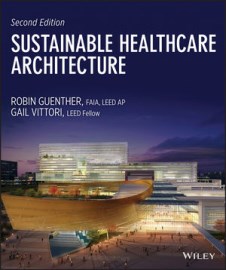
by Shane Henson — August 5, 2013—Anyone interested in the design, construction, and operation of state-of-the-art sustainable healthcare facilities can obtain new information on sustainable design approaches for hospitals and other healthcare facilities through a new book released in July 2013 by John Wiley & Sons Inc.
The book, Sustainable Healthcare Architecture, Second Edition, is written by Robin Guenther, a global sustainable healthcare design leader and principal of Perkins+Will, and Gail Vittori, a LEED (Leadership in Energy and Environmental Design) Fellow.
According to the authors, the second edition includes 80 percent new content and is packed with informative and thought-provoking special features.
“We’ve learned so much about what truly sustainable healthcare means since we released the first edition of Sustainable Healthcare Architecture in 2007,” said Guenther. “We’re constantly pushing the boundaries of what we mean when we talk about sustainability. The second edition really reflects the increased focus on issues such as materials transparency and resilient design, to name just a couple.”
Special features of this edition include:
- Fifty-five new project case studies, including comparisons of key sustainability indicators for general and specialty hospitals, sub-acute and ambulatory care facilities, and mixed-use buildings;
- New and updated guest contributor essays spanning a range of health-focused sustainable design topics;
- Evolving research on the value proposition for sustainable healthcare buildings;
- Profiles of five leading healthcare systems and their unique sustainability journeys, including the U.K. National Health Service, Kaiser Permanente, Partners HealthCare, Providence Health & Services, and Gundersen Health System;
- Focus on the intersection of healthcare, resilience, and a health promotion imperative in the face of extreme weather events; and
- Comparison of healthcare facility-focused green building rating systems from around the world.




